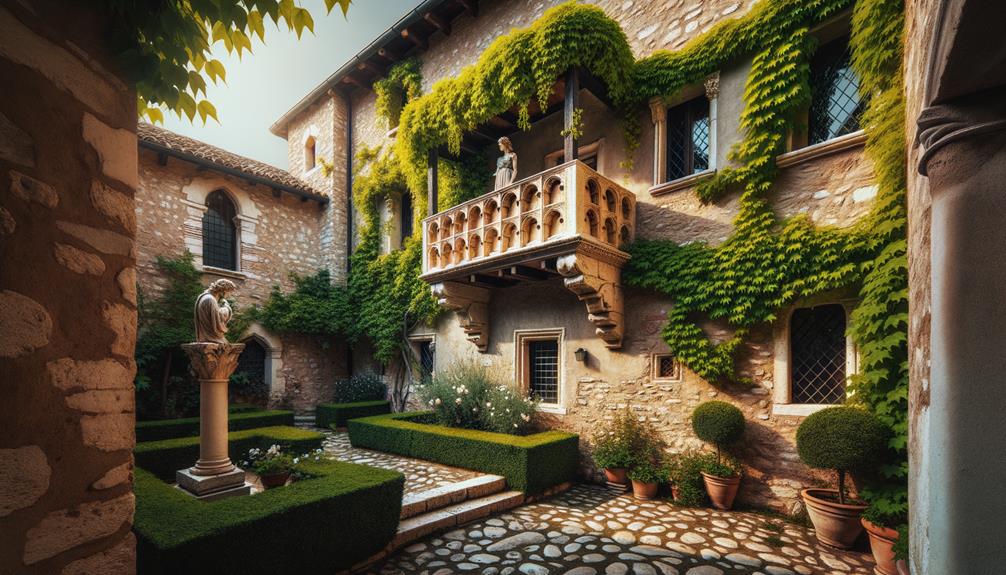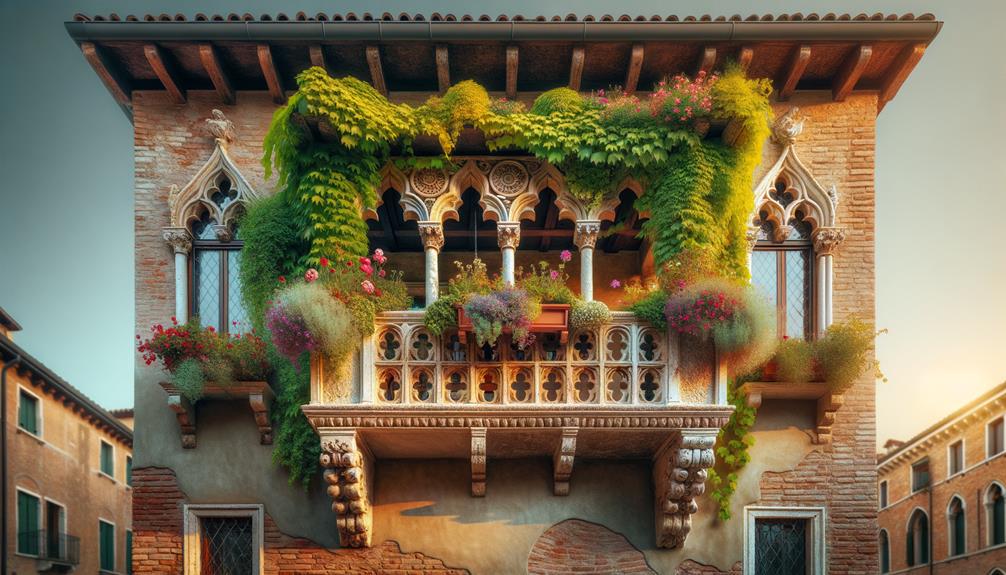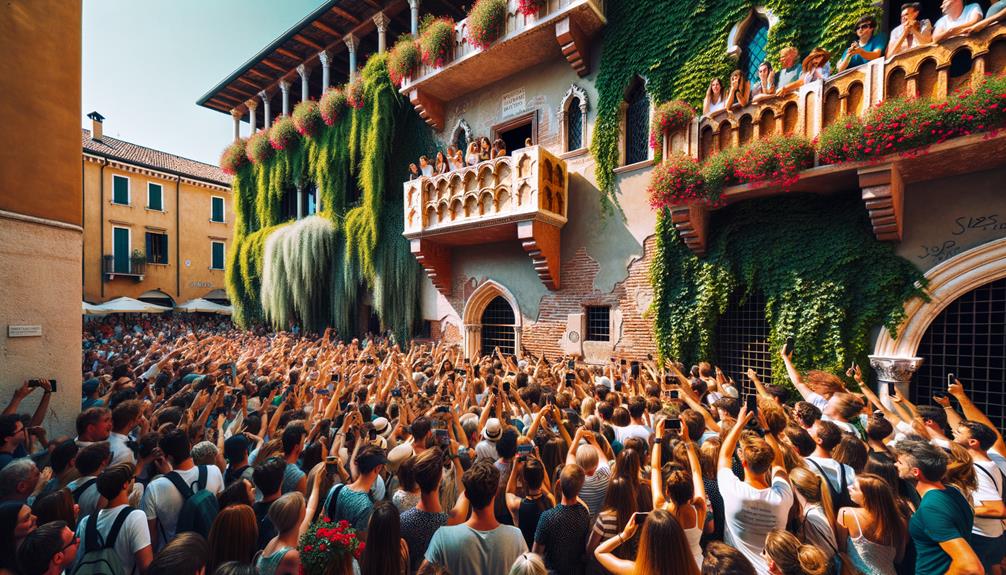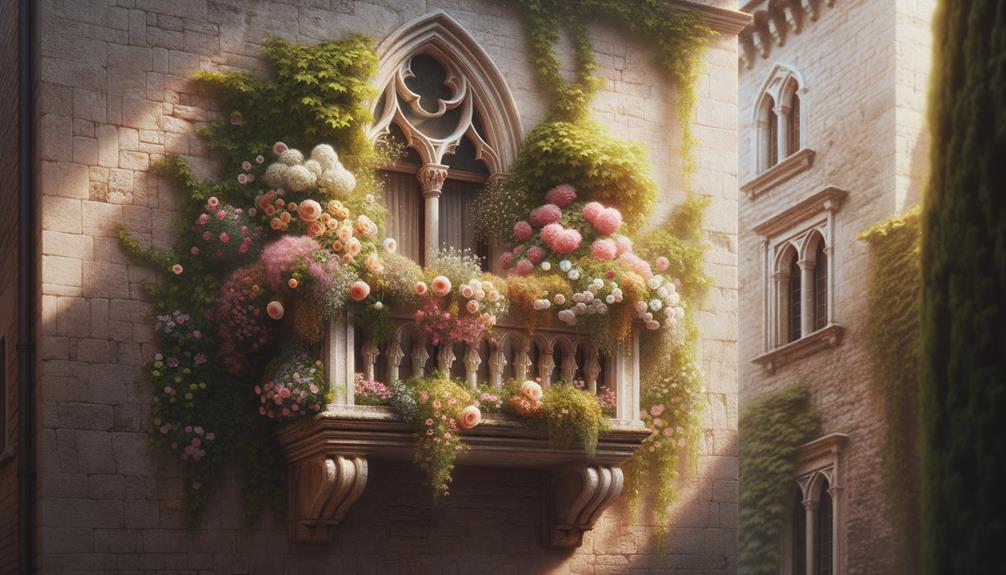Standing in the courtyard of Verona's Casa di Giulietta, I feel a mix of romantic nostalgia and a bit of skepticism. The famous balcony, crafted in the early 20th century, invites us to imagine the secret meetings of Shakespeare's star-crossed lovers. Antonio Avena transformed a simple medieval house into a global symbol of romance, yet it's interesting to consider how much of it is a modern creation. As I look at the Gothic-style balcony, which was salvaged from another site, I ponder the myths and realities that surround this iconic spot.
Origins of the Balcony
The story behind Juliet's balcony, a romantic emblem of eternal love, is rooted in a 20th-century initiative to turn an old building into a tourist spot. In the heart of Verona, the Casa di Giulietta, once home to the Cappello family, stands as a testament to this transformation. The city bought the building in 1905 and made significant changes to bring Shakespeare's famous love story to life.
Walking into the courtyard, you can almost feel the history. The medieval towers that once stood by the Cappello residence seem to whisper tales of the past. However, the famous balcony is actually a later addition. It's a piece of Gothic architecture taken from other medieval houses, dismantled to prevent flooding. This relic was carefully placed in the courtyard, more out of a sense of romance than historical accuracy.
Looking at the balcony, there's an appreciation for the mix of myth and reality. The 20th-century vision turned this modest house into a global destination for lovers. The streets of Verona, filled with echoes of love, show us how history can be shaped by dreams and desires.
Antonio Avena's Vision

Antonio Avena, with his keen eye for cultural heritage and a deep passion for romance, had a vision for Casa di Giulietta where history and legend would blend seamlessly. As the director of the Verona Civic Museum, Avena embarked on this project with the aim of creating a romantic atmosphere that would attract tourists from around the world. He saw the potential in the courtyard of the Cappello family's tower-house to become the centerpiece of this vision.
In the early 20th century, Avena cleverly installed a medieval balcony from demolished houses into the courtyard. This balcony, now famously known as Juliet's Balcony, was designed to evoke the timeless tale of love and tragedy. Despite not being original, the balcony has become a symbol of romance, drawing countless visitors to Verona.
Here's a glimpse of Antonio Avena's vision:
| Element | Description | Purpose |
|---|---|---|
| Juliet's Balcony | A medieval balcony placed in the courtyard | Create a romantic atmosphere |
| Courtyard | The central area of Casa di Giulietta | Serve as a focal point for tourists |
| Museum Project | Transforming the 14th-century building into a museum | Reinforce the legend of Romeo and Juliet |
Avena's legacy is the iconic Juliet's Balcony, a must-see attraction that embodies love and romance in Verona.
Architectural Features

How often do we pause to think about the unique mix of history and art that defines Juliet's Balcony? Standing in the courtyard of Casa di Giulietta, or the House of Juliet, it's hard not to be drawn in by the romantic charm of this iconic spot. The balcony, added in the 20th century, tells a captivating story. It was salvaged from medieval houses demolished to prevent river flooding and placed on the facade of a 14th-century building, part of the historic tower-house of the Cappello family.
The balcony itself dates back to the Gothic period, known for its pointed arches and intricate stonework. Antonio Avena, the director of the Verona Civic Museum, carefully chose its placement to fit seamlessly with the building's ancient charm. Standing beneath it, you can appreciate how the blend of authentic medieval stone and modern romantic imagination creates something special. The museum inside adds another layer of cultural depth, offering insights into Verona's rich history.
The courtyard, once spacious, now hums with modern amenities but still feels timeless. Here, the line between history and legend fades, creating a place where art and life come together.
Tourist Attraction Today

Stepping into Casa di Giulietta, you're immediately swept up in the romance that draws so many to this historic spot. The courtyard buzzes with tourists, all eager to snap a photo under Juliet's balcony. Couples line up to rub the bronze statue of Juliet, hoping it brings them luck in love. The statue itself shines brightly from years of being touched.
Inside, the museum displays Renaissance-era costumes and the bed from Franco Zeffirelli's 1968 film, ‘Romeo and Juliet.' It's a fascinating mix of history and Hollywood. The walls are plastered with love notes, stuck there with chewing gum, forming a colorful and heartfelt mosaic of emotions from around the world.
| Attraction | Description |
|---|---|
| Juliet's Balcony | Perfect spot for photos, representing romantic yearning |
| Museum | Features costumes and props from the 1968 film |
| Courtyard | Filled with tourists, includes the bronze statue of Juliet |
Outside, the courtyard walls are covered in graffiti and gum-shaped hearts. Volunteers respond to love letters left behind, as visitors pour their hearts out to Juliet. This spot in Verona isn't just a tourist attraction; it's a celebration of lasting love.
Misconceptions and Myths

Juliet's Balcony in Verona is a favorite stop for many visitors, but the real story behind this famous spot is full of misunderstandings and myths. The balcony at Casa di Giulietta isn't some ancient piece of history from the 13th century. In fact, it was added in the 20th century after the City of Verona bought the house in 1905. They put it there to create a romantic tourist attraction for Shakespeare fans.
Despite its charm, there's no proof that William Shakespeare ever visited Verona. The characters of Romeo and Juliet are entirely fictional, created by Shakespeare and inspired by older works from Italian writers like Luigi da Porto and Matteo Bandello. So, the story isn't based on real events or people.
The legend has become so powerful that it hides the fact that the balcony was a modern addition to enhance the fantasy. Walking through Verona's cobbled streets, it's striking how easily fiction blends with history, creating a lasting sense of allure and mystery.
Frequently Asked Questions
Why Is Juliet's Balcony in Verona Famous?
Juliet's balcony in Verona is famous for representing the clash between love and social expectations. Many couples visit, dreaming of breaking free from constraints, inspired by Shakespeare's timeless story of passion and rebellion.
Why Do People Touch Juliet's Breast in Verona?
In Verona, people touch Juliet's breast for luck in love. It's a mix of local tradition and a tourist ritual, creating a connection to Shakespeare's famous love story.
What's the Point of a Juliet Balcony?
"Home is where the heart is," they say. A Juliet balcony brings a touch of the outdoors inside, creating a cozy, open space to enjoy fresh air and lovely views. It adds a sense of freedom and a connection to nature.
Where Is the Original Romeo and Juliet Balcony?
The original Romeo and Juliet balcony never actually existed. It's a charming story that has captured imaginations, but in reality, it's just a legend. The famous balcony in Verona, which draws countless visitors, was added in the 20th century and, while romantic, isn't historically accurate.



